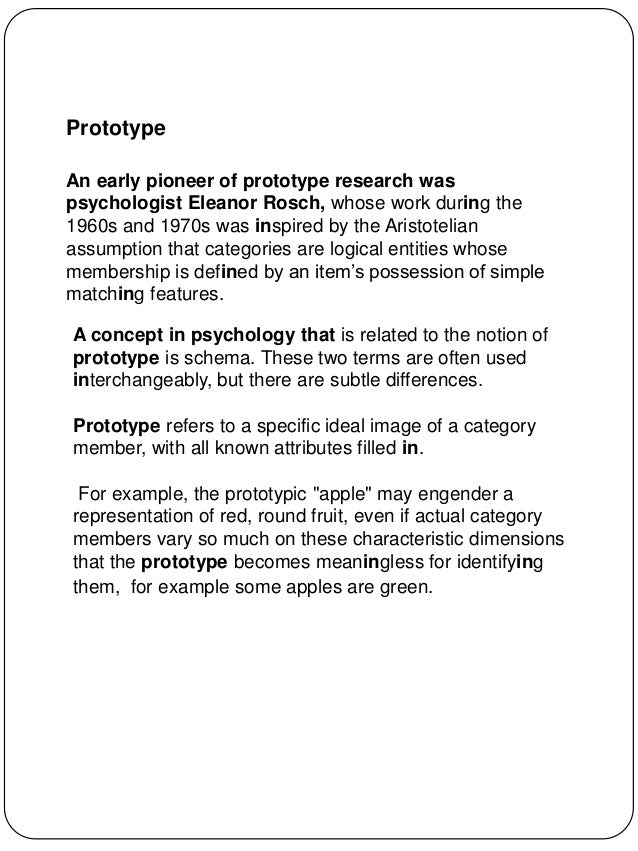Have you ever wondered how our brains categorize and make sense of the world around us? Well, buckle up because we're diving deep into the fascinating world of prototype psychology definition. This concept might sound complicated, but trust me, it's as simple as recognizing your favorite coffee shop or identifying a dog on the street. Prototype psychology plays a crucial role in how we perceive and process information every single day.
Imagine your brain as a super-efficient filing system, constantly sorting and organizing everything you see, hear, and experience. At the heart of this process lies the concept of prototypes – mental representations that help us quickly identify and classify objects, people, and situations. It's like having a mental blueprint for everything you encounter in life.
But why does this matter? Understanding prototype psychology can help us improve communication, enhance learning, and even design better products. So whether you're a psychologist, a marketer, or just someone curious about how the human mind works, this article is for you. Let's break it down step by step and uncover the secrets behind prototype psychology.
Read also:Leslie Abraham Menendez The Untold Story Behind The Iconic Figure
What Exactly is Prototype Psychology?
Prototype psychology refers to the way our brains use mental models to categorize and recognize patterns in the world. Think of it as a mental shortcut that allows us to quickly identify objects, people, or situations without overthinking. For example, when you see a four-legged animal with fur and a tail, your brain instantly categorizes it as a "dog" because it matches the prototype you've developed over time.
This concept was first introduced by cognitive psychologist Eleanor Rosch in the 1970s. She proposed that instead of relying on strict definitions, our brains use prototypes – idealized examples of categories – to make sense of the world. These prototypes are based on our experiences and the frequency with which we encounter certain objects or situations.
How Do Prototypes Work in Our Minds?
Prototypes function like mental templates that guide our perception and decision-making. When we encounter something new, our brain compares it to the prototype we've stored and determines whether it fits into a particular category. For instance, if you see a chair with three legs, your brain might still categorize it as a "chair" because it closely resembles the prototype you've developed over time.
However, prototypes are not rigid. They evolve as we gain more experiences and encounter new information. This flexibility allows us to adapt our mental models and expand our understanding of the world. For example, if you grow up in a culture where tea is served in a specific type of cup, your prototype for "teacup" might change if you travel and experience different tea-drinking traditions.
Key Features of Prototypes
- Central Tendency: Prototypes represent the average or most typical example of a category.
- Gradual Membership: Objects can belong to a category to varying degrees based on how closely they match the prototype.
- Context-Dependent: Prototypes can change depending on the context or situation.
- Experience-Based: Our prototypes are shaped by our personal experiences and cultural background.
Why is Prototype Psychology Important?
Understanding prototype psychology has practical applications in various fields, from education to marketing. By recognizing how people categorize and process information, we can design better communication strategies, improve user experiences, and even enhance teaching methods. For instance, marketers often use prototypes to create advertisements that resonate with their target audience's mental models.
In education, teachers can leverage prototype psychology to help students grasp complex concepts by relating them to familiar examples. This approach makes learning more intuitive and engaging. Additionally, prototype psychology plays a crucial role in cognitive science, helping researchers understand how the human mind processes information and makes decisions.
Read also:Capital Ale House The Premier Beer Destination In Harrisonburg Va
Applications in Everyday Life
- Designing User Interfaces: UX designers use prototypes to create intuitive interfaces that align with users' mental models.
- Improving Communication: Understanding prototypes can help you tailor your messages to better resonate with your audience.
- Enhancing Learning: Teachers can use prototypes to make abstract concepts more relatable and easier to understand.
Prototype Psychology vs. Classical Categorization
While prototype psychology emphasizes the use of mental models and gradual membership, classical categorization relies on strict definitions and binary classifications. In classical categorization, an object either belongs to a category or it doesn't. However, real-world categories are often more nuanced, which is where prototype psychology shines.
For example, consider the category "fruit." In classical categorization, an object is either a fruit or not. But in prototype psychology, some fruits might be considered "more fruit-like" than others based on how closely they match the prototype. This flexibility allows for a more realistic representation of how we perceive and categorize the world.
Strengths and Limitations
Strengths:
- Accounts for the complexity and variability of real-world categories.
- Explains how people handle ambiguous or atypical examples.
- Provides a more accurate model of human cognition.
Limitations:
- May not fully explain how people handle completely novel or unfamiliar categories.
- Relies heavily on individual experiences, which can lead to biases.
The Role of Experience in Shaping Prototypes
Our prototypes are heavily influenced by our personal experiences and cultural background. For example, someone who grows up in a coastal town might have a very different prototype for "beach" compared to someone who lives in a desert region. Similarly, cultural differences can lead to variations in prototypes for concepts like "family," "success," or "happiness."
This experience-based nature of prototypes has important implications for cross-cultural communication and understanding. By recognizing that others might have different mental models, we can become more empathetic and effective communicators.
How Culture Shapes Prototypes
- Different cultures may emphasize different features when defining categories.
- Cultural experiences can lead to the development of unique prototypes for concepts like "food," "clothing," or "music."
- Understanding cultural differences in prototypes can help bridge communication gaps and foster mutual understanding.
Prototypes in Decision-Making
Prototypes play a significant role in how we make decisions. When faced with a new situation, our brains quickly compare it to existing prototypes to determine the best course of action. For example, if you're trying to decide whether to trust a new acquaintance, your brain might compare them to your prototype of a "trustworthy person" based on past experiences.
However, relying too heavily on prototypes can lead to cognitive biases and errors in judgment. For instance, if your prototype for "successful person" is based on a narrow set of characteristics, you might overlook talented individuals who don't fit that mold.
Avoiding Prototype-Driven Biases
- Be aware of your own prototypes and how they influence your decisions.
- Seek out diverse experiences to expand and refine your mental models.
- Challenge your assumptions and be open to new information that doesn't fit your existing prototypes.
Prototype Psychology in Marketing
Marketers have long recognized the power of prototypes in shaping consumer behavior. By aligning their products or services with consumers' existing prototypes, marketers can create more effective advertising campaigns. For example, if your prototype for "luxury car" includes features like sleek design, advanced technology, and high performance, a car manufacturer might emphasize these attributes in their marketing materials.
However, marketers can also use prototypes to challenge and reshape consumers' mental models. By introducing new features or benefits that don't fit the traditional prototype, companies can differentiate themselves and create a lasting impression in the minds of consumers.
Strategies for Leveraging Prototypes in Marketing
- Identify and understand your target audience's existing prototypes.
- Create marketing messages that align with or challenge these prototypes.
- Use storytelling and visual elements to reinforce or redefine prototypes.
Future Directions in Prototype Psychology Research
While prototype psychology has come a long way since its introduction in the 1970s, there's still much to explore. Researchers are increasingly interested in how prototypes interact with other cognitive processes, such as memory, attention, and emotion. Additionally, advancements in neuroscience are shedding light on the neural mechanisms underlying prototype formation and use.
Another exciting area of research is the role of technology in shaping prototypes. As we interact more with digital platforms and AI systems, our mental models are evolving to incorporate new experiences and information. Understanding these changes can help us design better technologies that align with human cognition.
Emerging Trends in Prototype Psychology
- Exploring the intersection of prototypes and emotions in decision-making.
- Investigating how virtual reality and AI influence prototype formation.
- Studying the impact of social media on cultural prototypes and mental models.
Conclusion: Embracing the Power of Prototypes
In conclusion, prototype psychology offers a fascinating glimpse into how our brains make sense of the world. By understanding the role of prototypes in categorization, decision-making, and communication, we can improve our interactions with others and enhance our problem-solving abilities. Whether you're a psychologist, a marketer, or just someone curious about the human mind, prototype psychology has something to offer.
So next time you find yourself categorizing or recognizing something, take a moment to appreciate the incredible power of your mental prototypes. And remember, our prototypes are constantly evolving, so keep an open mind and be willing to learn from new experiences. Now it's your turn – share your thoughts in the comments below or check out our other articles for more insights into the wonders of the human mind.
Table of Contents
- What Exactly is Prototype Psychology?
- How Do Prototypes Work in Our Minds?
- Why is Prototype Psychology Important?
- Prototype Psychology vs. Classical Categorization
- The Role of Experience in Shaping Prototypes
- Prototypes in Decision-Making
- Prototype Psychology in Marketing
- Future Directions in Prototype Psychology Research
- Emerging Trends in Prototype Psychology
- Conclusion: Embracing the Power of Prototypes


